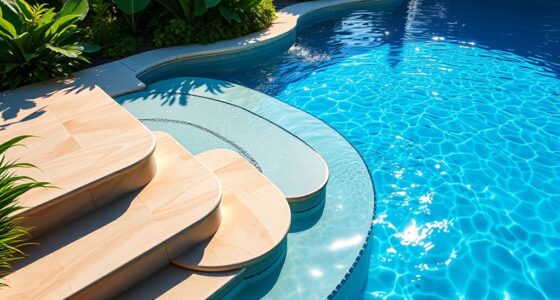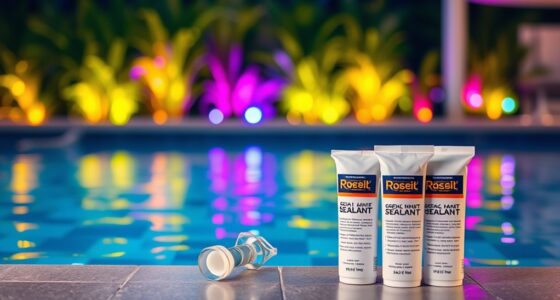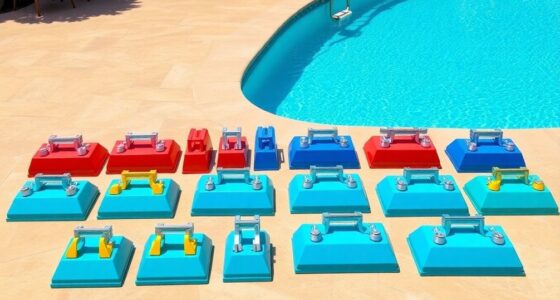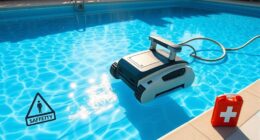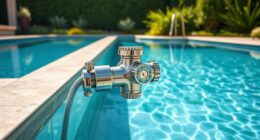Pool pump replacements work by disconnecting the old pump and installing a new one to maintain your pool’s efficiency. First, turn off the power and gather your tools. Next, safely remove electrical and plumbing connections. After securing the new pump, make sure all connections are tight to prevent leaks. Finally, check for proper operation. Keeping your pump updated enhances water circulation and saves on energy costs. Want to discover more about the process?
Key Takeaways
- Pool pump replacements improve water circulation and maintain pool cleanliness by ensuring efficient operation of the filtration system.
- The replacement process involves safely disconnecting the old pump, including electrical and plumbing connections.
- Proper installation of the new pump includes securing it, reattaching plumbing lines, and testing for leaks to ensure functionality.
- Regular maintenance and adherence to warranty terms are essential for the longevity and efficiency of the new pump.
- Understanding the components involved, such as motor and seals, can aid in a successful replacement and prevent future issues.
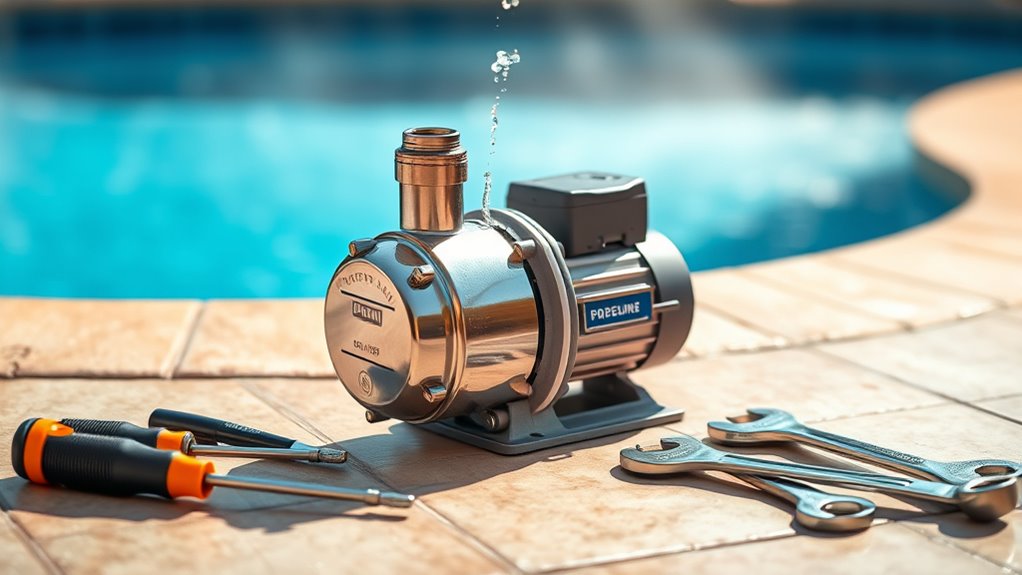
Replacing your pool pump is an essential task that can enhance your pool’s efficiency and longevity. Before diving into the replacement process, you’ll need to gather the right tools and materials. Make certain you have pliers, screwdrivers, and wrenches handy for loosening connections, along with plumber’s tape and new seals or gaskets to prevent leaks.
Safety should always come first; turn off the power at the circuit breaker and wear protective gear like gloves and safety glasses. A dry, well-lit workspace will also make your job easier and safer.
Always prioritize safety by turning off the power, wearing protective gear, and ensuring a well-lit workspace.
Once you’ve prepared, disconnect the electrical connections. Verify the power is completely off at the circuit breaker to avoid any electrical hazards. Use your tools to remove the electrical connectors carefully, and have basic electrical supplies on standby. Consulting diagrams can help you disconnect the wiring correctly, minimizing the risk of mistakes.
Keep the area dry to protect against electrical shocks as you work.
Next, you’ll remove the existing pump. Start by disconnecting the plumbing lines from the old pump. Loosen the bolts securing the pump to its mounting, and make sure to lift and move the old pump safely. Remember to dispose of it responsibly.
Before installing the new pump, inspect it for any damage to verify a smooth replacement process.
When it comes to installing the new pump, alignment and placement are key. Position it correctly and tighten the bolts to secure it in place. Reconnect the plumbing lines using plumber’s tape to create a watertight seal.
After everything’s connected, test for leaks to verify no water escapes when the pump is running. Once you’ve checked for leaks, it’s time to start the pump and verify it operates properly.
If you’re also replacing the pump motor, loosen the bolts to remove the old motor from the pump and transfer essential parts like the impeller and shaft seal to the new motor.
Install the shaft seal carefully before securing the new motor back into the pump housing. After everything is in place, perform final checks to make certain all connections are secure and leak-free.
Finally, after replacing the pump, conduct thorough leak tests and verify the new pump operates smoothly. Verify all electrical connections are secure and safe.
Don’t forget to schedule regular maintenance to extend the lifespan of your new pump, and review the warranty terms to know your coverage.
Frequently Asked Questions
How Long Does a Pool Pump Typically Last Before Replacement?
A pool pump typically lasts between 8 to 15 years, depending on its quality and how often you use it.
If you maintain it regularly, you can extend its lifespan considerably.
Keep an eye on its performance; if you notice decreased efficiency or increased energy consumption, it might be time for a replacement.
Environmental conditions and the quality of water also play a role in how long your pump will last.
Can I Replace a Pool Pump Myself or Hire a Professional?
You can definitely replace a pool pump yourself, but weigh the pros and cons.
DIY saves money and gives you hands-on experience, but you’ll need some plumbing and electrical knowledge.
If you’re unsure, hiring a professional guarantees the job’s done right, though it costs more.
Consider your comfort level with tools and safety, plus how quickly you want the job done.
Ultimately, it’s about what suits you best.
What Are the Signs That My Pool Pump Needs Replacement?
Your pool pump’s humming along, but it’s also showing signs of age.
If you notice strange noises, leaks, or reduced water flow, it’s time to pay attention. Increased energy bills and frequent maintenance calls can’t be ignored either.
Furthermore, if it’s overheating or vibrating excessively, those are red flags.
Are There Energy-Efficient Options for Pool Pump Replacements?
Yes, there are energy-efficient options available for pool pump replacements.
You can choose variable speed pumps, which adjust their speed to fit your pool’s needs, greatly reducing energy consumption. These pumps can save you money on electricity bills and have a shorter payback period.
Plus, ENERGY STAR certified models guarantee you’re making an environmentally friendly choice.
Investing in one of these options will enhance your pool experience while benefiting your wallet and the planet.
How Do I Choose the Right Size Pump for My Pool?
To choose the right size pump for your pool, start by calculating your pool’s volume.
Then determine the ideal flow rate based on that volume and your desired turnover rate.
Consider the type of pool you have and any additional features like water spouts.
Don’t forget to factor in plumbing size and head pressure.
Finally, make sure your pump matches your filter’s capacity to maintain efficient circulation and maximum performance.
Conclusion
In the grand scheme of pool maintenance, replacing your pump is like giving your oasis a much-needed revitalizing boost. Just as Hercules had to tackle his labors, you too can conquer this task with confidence. By understanding how your new pump works and ensuring it’s the right fit for your pool, you’ll keep the water sparkling and inviting. So plunge in, embrace the change, and watch your backyard paradise thrive!


